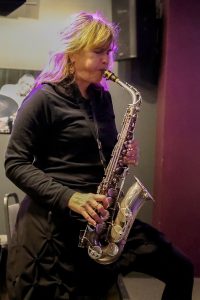PHOENIX – The Nash Jazz Club in downtown Phoenix is hosting a new multiyear “Women in Jazz” initiative to address gender inequities in jazz music. The initiative includes The Nash Jazz DivAZ program, which teaches middle- and high-school girls concert jazz music.
The Nash has been a staple in downtown Phoenix since 2012 and has focused on “celebrating the rich tradition and ongoing innovation of jazz,” according to its website, but recently its efforts have shifted to getting more young women involved in the genre.
“It’s really not our goal to only play with women, and it’s unrealistic to have that expectation,” said Mary Petrich, who is the artistic director of the women’s initiative. “I am also a player, and I love my male colleagues. However, it is important that we feel that we have women leaders, as many women leaders as we have men leaders. … If they feel confident and strong going out into any musical situation, then we’ve done our job.”
Petrich, an experienced saxophonist who teaches the Jazz DivAZ classes, has experienced the gender inequities of jazz firsthand and knows the importance of changing the culture.
“I’ve had guy colleagues telling me that girls can’t play jazz to my face. I’ve had colleagues say that they should be sitting in my seat, they should be playing the chair that I’m playing, they should be teaching in the position I’m teaching,” Petrich said.

Mary Petrich plays the saxophone to help the DivAZ class perform a song on Oct. 21 at The Nash Jazz Club in Phoenix. (Photo by Sam Volante/Cronkite News)
The changing culture is exemplified by Jazz DivAZ students such as bassist Summer Lee, who is 15.
“I think it’s important because women are half the population and we want to contribute our own sound to this. I think it’s great that The Nash has a program that will train young women to start learning how to play music where we can make mistakes, and so if we want to go out into the real world and play, we can help to do our best,” Lee said.
Lee plays both cello and bass and has not only felt an improvement in her music and her ability to stay on beat but has also learned a more valuable life lesson from the classes.
“Jazz has taught me to listen to those around you,” she said.
Other students mentioned improvements such as better soloing and being more confident in their play after taking the classes. Some said it even helped them in their school bands.
The Women in Jazz initiative extends beyond the DivAZ program: Nationally renowned saxophonist Roxy Coss kicked off the initiative with a performance at The Nash Jazz Club in October.
“I think it’s powerful,” Petrich said of Coss’ performance. “You can say, ‘We need women,’ and judge; you can just talk until you’re blue in the face. Until we see it, until I stand next to somebody who’s doing that and experience that energy – to me, that’s when it really becomes real.”
After the performance, there was a panel discussion allowing students to speak to role models and people who are changing the jazz landscape.
The Jazz DivAZ program will culminate with a live performance at 7 p.m. on Dec. 3 as part of the Nash Education Concert.


